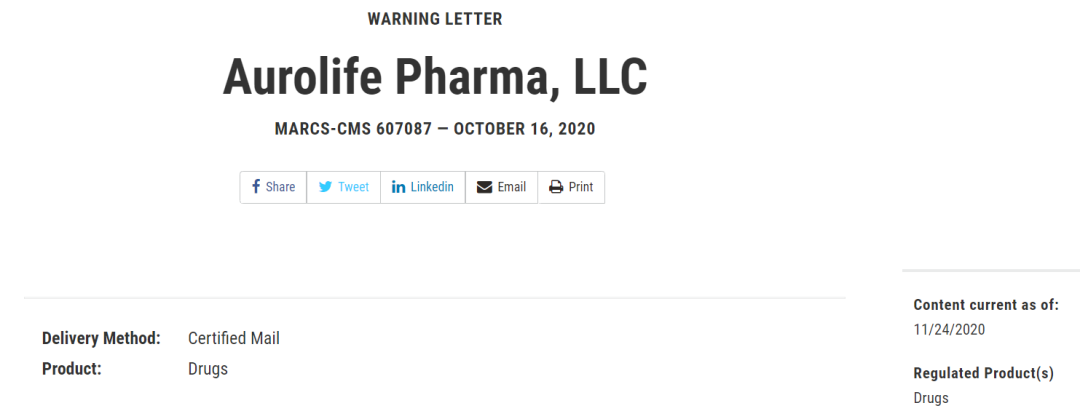扫一扫 添加小助手
服务热线
13818320332
扫一扫 关注我们
 11月24日,FDA公布一封针对美国企业(AuroLife Pharma, LLC,总部位于印度)的警告信。主要的缺陷项涉及OOS调查不充分、厂房维护不利、设施设备的清洁问题和针对工艺变更的验证不足。
11月24日,FDA公布一封针对美国企业(AuroLife Pharma, LLC,总部位于印度)的警告信。主要的缺陷项涉及OOS调查不充分、厂房维护不利、设施设备的清洁问题和针对工艺变更的验证不足。
对于厂房维护问题,检查中FDA发现:该公司的胶囊灌装间天花板有四次漏水事件,而包装区域中至少有五处漏水的情况,漏水时该公司正在进行多批产品的生产,而公司未经充分评估即放行了这些批次。对此,公司承诺将召回在FDA 483表格中明确列出的批次,但FDA认为公司未能阐述:对于这些漏水带来的风险,为什么公司的管理层未能充分认识到?

WARNING LETTER
CMS# 607087
警告信
CMS#607087
October 16, 2020
Dear Mr. Reddy:
2020年10月16日
亲爱的雷迪先生:
The U.S. Food and Drug Administration (FDA) inspected your drug manufacturing facility, AuroLife Pharma, LLC, FEI 3005796917, at 2400 Route 130 North, Dayton, New Jersey, and 6 Wheeling Road, Dayton, New Jersey, from January 13 to February 12, 2020.
2020年1月13日至2月12日,美国食品药品监督管理局(FDA)对你们的药品生产设施AuroLife Pharma, LLC,FEI 3005796917进行了检查,位于美国新泽西州代顿。
This warning letter summarizes significant violations of current good manufacturing practice (CGMP) regulations for finished pharmaceuticals. See Title 21 Code of Federal Regulations (CFR), parts 210 and 211 (21 CFR parts 210 and 211).
该警告信总结了严重违反制剂CGMP规定的情况。请参阅21CFR第210和211部分。
Because your methods, facilities, or controls for manufacturing, processing, packing, or holding do not conform to CGMP, your drug products are adulterated within the meaning of section 501(a)(2)(B) of the Federal Food, Drug, and Cosmetic Act (FD&C Act), 21 U.S.C. 351(a)(2)(B).
由于你们用于生产、加工、包装或储存的方法、设施或控制措施不符合CGMP,因此根据FD&C法案501(a)(2)(B)条及21 U.S.C.351(a)(2)(B) 条的规定,你们的药品被认为是掺假。
We reviewed your March 5, 2020, response to our Form FDA 483 in detail and acknowledge receipt of your subsequent correspondence.
我们详细审查了你们于2020年3月5日对FDA 483表格的答复,并确认收到你们的后续信件。
During our inspection, our investigators observed specific violations including, but not limited to, the following.
在我们的检查过程中,调查员发现了具体的违规行为,包括但不限于以下行为。
OOS调查不充分
1. Your firm failed to thoroughly investigate any unexplained discrepancy or failure of a batch or any of its components to meet any of its specifications, whether or not the batch has already been distributed (21 CFR 211.192).
1.公司未能彻底调查批次或其中任何组分的任何无法解释的差异或故障,无法满足其质量标准,无论批次是否已经分发(21 CFR 211.192)。
Your firm invalidated initial out-of-specification (OOS) impurity testing results for your olanzapine active pharmaceutical ingredient (API) and finished drug product without sufficient investigation to determine the root cause of the failures.
对奥氮平活性药物成分(API)和成品药物的杂质检验,就其初始不合格(OOS)结果,你们公司判定为无效,但没有进行充分的调查,以确定失败的根本原因。
For example, during impurity testing of olanzapine tablets, batch #56119018, an impurity at relative retention time (RRT) (b)(4) was calculated at a concentration of 0.3%, which exceeded the specification for any unidentified impurity (not more than (b)(4)%). You did not adequately investigate this impurity result.
例如,在奥氮平片剂#56119018的杂质检验中,相对保留时间(RRT)XX的杂质计算浓度为0.3%,该杂质含量超出了未鉴别杂质的质量标准(不超过XX%)。你们没有充分研究此杂质结果。
During the OOS investigation, you confirmed the OOS results twice using the original sample. Then you tested a new sample from the same batch with a passing result, and only reported the passing re-test result. Without supporting evidence, you concluded that the impurity results were due to contamination from the mortar and pestle.
在OOS调查期间,你们使用原始样本两次确认OOS结果。然后,你们对同一批次中的新样品进行了检验,结果为合格,且仅报告了合格的重新检验结果。在没有支持证据的情况下,你们得出结论,杂质结果是由于研钵和研杵的污染所致。
Furthermore, you failed to investigate impurity OOS test results for olanzapine API used to make your olanzapine tablets. For example, six lots of this API exceeded the specification limit of (b)(4)% for an unknown impurity at RRT (b)(4).
此外,你们没有调查用于制备奥氮平片剂的奥氮平API的杂质OOS检验结果。例如,对于RRT XX处的未知杂质,该API六个批次超出了XX%的质量标准限度。
You did not adequately investigate these impurity test failures. You released five of these API lots for finished drug production and rejected one. In the rejected lot, (b)(4), you observed a high unknown impurity at another RRT. During the inspection, firm personnel indicated that this lot had experienced high temperature excursions while in storage.
对于这些杂质的检验失败,你们没有充分调查。你们放行了其中五批次用于成品药生产的API,但拒放了其中一批次。在拒放的批次XX中,你们在另一个RRT位置观察到高浓度的未知杂质。在检查过程中,公司人员表示这批货物在储存时经历了高温波动。
You had prolonged problems assuring maintenance of the required temperatures of the refrigerated storage unit in which this API was stored.
你们长期存在问题:对于储存的此API的冷藏柜,无法保证其所需的温度。
While you attributed the OOS results at (b)(4) RRT to HPLC method issues that included lack of column prewashing, you failed to implement the corrective action in a timely fashion. Following our inspection, you tested at least (b)(4) more lots before making this correction to the method.
虽然你们将XX RRT上的OOS结果归因于HPLC方法问题,其中包括缺乏色谱柱预清洗,但你们未能及时实施纠正措施。根据我们的检查,在对方法进行校正之前,你们至少检验了XX批次。
In your response, you wrote that your firm will re-evaluate the OOS results for batch #56119018 and recall the batch if necessary. Regarding the olanzapine API, you wrote that your “QC management verified all the tested and released lots for the subject peak at (b)(4) RRT” and determined the API lots were within specifications. You also wrote that you agreed that your OOS investigation procedure was inadequate and needed revision.
在答复中,你们写道你们公司将重新评估批次#56119018的OOS结果,并在必要时召回该批次。关于奥氮平API,你们写道:“QC管理人员验证了XX RRT的所有检验和放行批次的目标峰,并确定API批次在质量标准限度内”。你们还写道,你们同意你们的OOS调查程序不充分,需要进行修订。
Your response is inadequate. We disagree with your conclusion that there was sufficient evidence to invalidate the OOS results for the five lots of olanzapine API. You also did not perform a retrospective assessment to identify all OOS results that were invalidated by your laboratory without strong scientific justification and clear evidence. Additionally, your revised OOS procedure remains insufficient. For example, it failed to ensure a thorough investigation of potential manufacturing causes is initiated whenever a laboratory cause cannot be conclusively identified.
你们的回应不充分。我们不同意你们的结论,即有足够的证据判定五批奥氮平API的OOS结果无效。你们也没有执行回顾性评估,来确定所有被实验室判定为无效的OOS结果,而没有强大科学依据和明确证据。此外,你们修改的OOS程序仍然不够。例如,当不能最终确定实验室原因时,你们无法确保启动对潜在生产原因的彻底调查。
In response to this letter, provide:
针对此信,请提供:
• The identity of the impurities at RRT (b)(4) and (b)(4) seen in lot (b)(4) of olanzapine API that failed for unknown impurities (specification NMT (b)(4)%). After you identify these impurities:
o Determine if these impurities were potentially seen in forced degradation studies
o Determine which root cause(s) was most likely to be associated with the degradant(s) found
o Expand your investigation of OOS results at similar RRT in other batches of olanzapine API, and perform identification and proper root cause analysis
•奥氮平API批次XX因未知杂质而失败(质量标准NMT XX%),需要鉴别该批RRT XX和XX处的杂质。在确定了这些杂质之后:
o确定在强制降解研究中,是否可能发现了这些杂质
o就发现的降解物,确定相关的最有可能的根本原因
o就其它批次的奥氮平 API,扩大对类似RRT OOS结果的调查,并进行鉴别和适当的根本原因分析
• A review of all batches of olanzapine API that were stored, or potentially stored, under the same conditions as the failed batch.
•查看在与失败批次相同的条件下存储(或潜在在此条件下存储)的所有奥氮平API批次。
• A summary of all test results for each lot of olanzapine API received by your firm, regardless of whether the data was invalidated or if the lot was rejected. Test results for each lot should include each data point generated.
•就你们公司收到的每批奥氮平 API,提供所有检验结果的摘要,无论数据是否无效、或批次是否被拒收。每个批次的检验结果应包括每个生成的数据点。
• A comprehensive, independent assessment of your laboratory practices, procedures, methods, equipment, documentation, and analyst competencies. Based on this review, provide a detailed plan to remediate and evaluate the effectiveness of your laboratory system.
•对你们的实验室实践、程序、方法、设备、文档和分析人员的能力,进行全面、独立的评估。在此审查的基础上,提供详细计划以补救和评估实验室系统的有效性。
• A retrospective, independent review of all invalidated OOS (including in-process and release/stability testing) results for products currently in the U.S. market and within expiry as of the date of this letter and a report summarizing the findings of the analysis, including the following for each OOS:
•就美国销售、仍在效期内的产品,回顾并独立审查的所有无效OOS结果(包括过程中和放行/稳定性检验),以及一份总结分析结果的报告,就每个OOS包括以下内容:
o Determine whether the scientific justification and evidence relating to the invalidated OOS result conclusively or inconclusively demonstrates causative laboratory error.
o确定与无效OOS结果有关的科学依据和证据,能否结论性地说明是由实验室原的错误造成的。
o For investigations that conclusively establish laboratory root cause, provide rationale and ensure that all other laboratory methods vulnerable to the same or similar root cause are identified for remediation.
o对于最终确定根本原因为实验室问题的调查,应提供理由,并确保确定了所有其它易受相同或相似根本原因影响的实验室方法,以进行补救。
o For all OOS results found by the retrospective review to have an inconclusive or no root cause identified in the laboratory, include a thorough review of production (e.g., batch manufacturing records, adequacy of the manufacturing steps, suitability of equipment/ facilities, variability of raw materials, process capability, deviation history, complaint history, batch failure history). Provide a summary of potential manufacturing root causes for each investigation, and any manufacturing operation improvements.
O在回顾性检查中,对于发现OOS结果在实验室中没有确定的根本原因,或没有根本原因的情况,应包括对生产的全面检查(例如,批生产记录、生产步骤是否适当、设备/设施的适用性,原材料、工艺能力、偏差历史记录、投诉历史记录和批次失败历史记录)。汇总每次调查的潜在生产根本原因,以及任何生产操作改进。
• A comprehensive review and remediation plan for your OOS result investigation systems. The corrective action and preventive action (CAPA) plan should include but not be limited to addressing the following:
•针对你们的OOS结果调查系统的全面审查和补救计划。CAPA应该包括但不限于解决以下问题:
o Quality unit oversight of laboratory investigations
o Identification of adverse laboratory control trends
o Resolution of causes of laboratory variation
o Initiation of thorough investigations of potential manufacturing causes whenever a laboratory cause cannot be conclusively identified
o Adequately scoping each investigation and its CAPA
o Revised OOS investigation procedures with these and other remediations.
o质量单元对实验室调查的监督
o实验室控制异常趋势的识别
o解决实验室波动的原因
o每当无法最终确定实验室原因时,就对潜在的生产原因进行彻底调查
o充分界定每个调查及其CAPA的范围
o通过这些和其它补救措施修订OOS调查程序
厂房维护
2. Your firm failed to maintain buildings used in the manufacture, processing, packing or holding of drug products in a good state of repair (21 CFR 211.58).
2.就用于生产、加工,包装或保存药品的厂房,你们公司未能保持良好的维修状态(21 CFR 211.58)。
You failed to adequately maintain your facility in a good state of repair.
你们未能充分维护设施的良好维修状态。
For example, in 2018, you had four incidences of water leakage from the ceiling of your encapsulation room (b)(4). Gabapentin capsules, USP 100 mg, were exposed to these leaks during multiple batch encapsulation operations. You also experienced water leaks during encapsulation operations of phentermine capsules.
例如,在2018年,你们有四次从胶囊灌装间天花板XX漏水的事件。在多批灌装操作期间,加巴喷丁胶囊USP 100 mg暴露于这些漏水事件中。在芬特明胶囊的灌装操作过程中,你们也遇到了漏水的情况。
In addition, there were at least five instances of water leaks in your packaging area (rooms (b)(4) and (b)(4)). Some occurred while you were filling tablets into open containers. Some of these leaks occurred above the packaging lines.
此外,在你们的包装区域(房间XX和XX)中至少有五处漏水的情况。当你们将药片装进开放的容器中时,也发生了这样的一些事情。其中一些漏水发生在包装线上方。
Your failure to ensure that your facility is adequately maintained may pose a risk to the quality of your finished drug products, including the moisture sensitive drug, pioglitazone HCL tablets.
如果你们未能确保设施得到充分维护,可能会对成品制剂的质量构成风险,包括对水分敏感的药物盐酸吡格列酮片剂。
Your firm failed to ensure that the root cause of these leaks was addressed promptly and to adequately assess the risks due to exposure of products to elevated ambient moisture.
你们公司无法确保及时解决这些泄漏的根本原因,并且无法充分评估由于产品暴露于高湿度环境而导致的风险。
In your response, we acknowledge you have committed to recalling the batches that were specifically listed on the Form FDA 483 in Observation #1. You also wrote that you plan to add a requirement to examine CAPA effectiveness and develop a new procedure for handling production anomalies. Your response failed to address why your executive management failed to fully recognize the risks from these leaks, and adequately address how you will ensure that facility repairs are addressed promptly.
在你们的答复中,我们确认:你们已承诺召回在FDA 483表中1号观察项中明确列出的批次。你们还写道,你们打算添加一项要求,以检查CAPA有效性,并开发一种处理生产异常的新程序。你们的答复未能解决:为什么管理层未能充分认识到这些泄漏带来风险的原因,并且没有充分说明:你们将如何确保迅速解决设施维修的问题。
In response to this letter, provide:
针对此信,请提供:
• Your CAPA plan to implement routine, vigilant operations management oversight of facilities and equipment. This plan should ensure, among other things, prompt detection of equipment/facilities performance issues, effective execution of repairs, adherence to appropriate preventive maintenance schedules, timely technological upgrades to the equipment/facility infrastructure, and improved systems for ongoing management review. Your plan should also ensure that appropriate actions are taken throughout the company network.
•你们的CAPA计划:对设施和设备实施例行的、警惕的运营管理监督。该计划应确保除其它事项外,迅速发现设备/设施性能问题,有效执行维修,遵守适当的预防性维护计划,及时对设备/设施基础设施进行技术升级,以及改进系统以进行持续的管理审查。你们的计划还应确保:在整个公司网络中采取适当的措施。
• A retrospective review of drugs that may have been negatively impacted, including both chemical (e.g., dissolution, degradants) and microbiological attributes. The review should include factors such as elevated moisture levels due to leaks, and also include assessment of all records that would yield such information, including records on maintenance, deviations, and facility repairs.
•回顾性审查:针对可能受到不利影响的药物,包括化学(例如溶出度、降解物)和微生物属性。审查应包括:诸如由于泄漏引起的水分含量升高等因素,还应包括对所有会产生此类信息的记录的评估,包括维护、偏差和设施维修的记录。
• Test retain samples of moisture sensitive drugs manufactured during periods that leakage occurred in your facilities.
•就在工厂发生泄漏期间生产的水分敏感药物,对其留样进行检验。
Ref.: [FDA][2020-11-24]WARNING LETTER-Aurolife Pharma, LLC
文章来源:PharmLink
本网站刊载的所有内容,包括文字、图片、音频、视频、软件等,如非标注为“原创”,则相关版权归原作者所有,如原作者不愿意在本网站刊登相关内容,请及时通知本站,我们将第一时间予以删除。